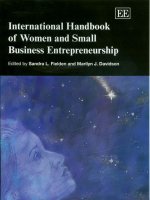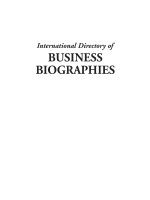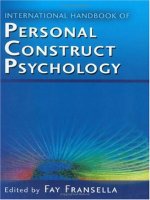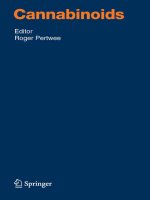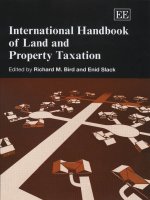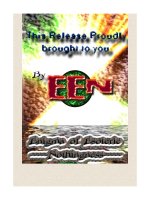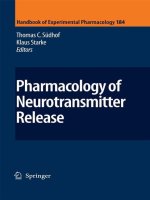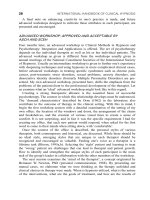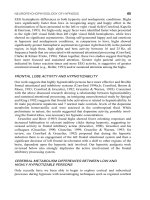International handbook of teacher education volume 1
Bạn đang xem bản rút gọn của tài liệu. Xem và tải ngay bản đầy đủ của tài liệu tại đây (7.88 MB, 585 trang )
John Loughran
Mary Lynn Hamilton Editors
International
Handbook
of Teacher
Education
Volume 1
International Handbook of Teacher Education
John Loughran • Mary Lynn Hamilton
Editors
International Handbook
of Teacher Education
Volume 1
Editors
John Loughran
Faculty of Education
Monash University
Clayton, Victoria, Australia
Mary Lynn Hamilton
School of Education
University of Kansas
Lawrence, Kansas, USA
ISBN 978-981-10-0364-6
ISBN 978-981-10-0366-0
DOI 10.1007/978-981-10-0366-0
(eBook)
Library of Congress Control Number: 2016938695
© Springer Science+Business Media Singapore 2016
This work is subject to copyright. All rights are reserved by the Publisher, whether the whole or part of
the material is concerned, specifically the rights of translation, reprinting, reuse of illustrations, recitation,
broadcasting, reproduction on microfilms or in any other physical way, and transmission or information
storage and retrieval, electronic adaptation, computer software, or by similar or dissimilar methodology
now known or hereafter developed.
The use of general descriptive names, registered names, trademarks, service marks, etc. in this publication
does not imply, even in the absence of a specific statement, that such names are exempt from the relevant
protective laws and regulations and therefore free for general use.
The publisher, the authors and the editors are safe to assume that the advice and information in this book
are believed to be true and accurate at the date of publication. Neither the publisher nor the authors or the
editors give a warranty, express or implied, with respect to the material contained herein or for any errors
or omissions that may have been made.
Printed on acid-free paper
This Springer imprint is published by Springer Nature
The registered company is Springer Science+Business Media Singapore Pte Ltd.
Contents of Volume 1
Part I
Organisation and Structure of Teacher Education
1
Developing an Understanding of Teacher Education ..........................
John Loughran and Mary Lynn Hamilton
2
The History of Initial Teacher Preparation
in International Contexts .......................................................................
Peggy L. Placier, Moeketsi Letseka, Johannes Seroto,
Jason Loh, Carmen Montecinos, Nelson Vásquez, and Kirsi Tirri
3
23
3
Structure of Teacher Education.............................................................
Cheryl J. Craig
4
Approaches to Teacher Education ......................................................... 137
Julian Kitchen and Diana Petrarca
5
Teacher Education Curriculum ............................................................. 187
Maria Assunção Flores
6
The Practicum: The Place of Experience?............................................ 231
Simone White and Rachel Forgasz
7
Reform Efforts in Teacher Education ................................................... 267
Clare Kosnik, Clive Beck, and A. Lin Goodwin
Part II
69
Knowledge and Practice of Teacher Education
8
Pedagogy of Teacher Education............................................................. 311
Fred A.J. Korthagen
9
Pedagogical Content Knowledge in Teacher Education ...................... 347
Amanda Berry, Fien Depaepe, and Jan van Driel
10
Pedagogical Reasoning in Teacher Education ...................................... 387
John Loughran, Stephen Keast, and Rebecca Cooper
v
vi
Contents of Volume 1
11
The Place of Subject Matter Knowledge in Teacher
Education ................................................................................................. 423
Marissa Rollnick and Elizabeth Mavhunga
12
Professionalising Teacher Education: Evolution
of a Changing Knowledge and Policy Landscape ................................ 453
Diane Mayer and Jo-Anne Reid
13
Learning from Research on Beginning Teachers ................................. 487
Beatrice Avalos
14
Teacher Education as a Moral Endeavor.............................................. 523
Cees A. Klaassen, Richard D. Osguthorpe, and Matthew N. Sanger
Author Biographies ......................................................................................... 559
Index ................................................................................................................. 573
Contents of Volume 2
Part III
Teacher Educators
15
Personal Practical Knowledge of Teacher Educators ..........................
Vicki Ross and Elaine Chan
16
Beginning Teacher Educators: Working in Higher
Education and Schools............................................................................
Jean Murray
3
35
17
Reflective Practice ...................................................................................
Carol Rodgers and Vicki Kubler LaBoskey
18
Mentoring ................................................................................................ 105
Lily Orland-Barak
19
Exploring the Complex Concept of Quality
in Teacher Education .............................................................................. 143
Tom Russell and Andrea K. Martin
20
Intimate Scholarship: An Examination of Identity
and Inquiry in the Work of Teacher Educators ................................... 181
Mary Lynn Hamilton, Stefinee Pinnegar, and Ronnie Davey
21
Teacher Education for Educational and Social Transformation ........ 239
Lorena I. Guillén, Camila I. Gimenes, and Ken M. Zeichner
Part IV
71
Students of Teaching
22
Factors Influencing Teaching Choice: Why Do Future
Teachers Choose the Career? ................................................................. 275
Paul W. Richardson and Helen M.G. Watt
23
Being a Student of Teaching: Practitioner Research
and Study Groups ................................................................................... 305
Robert V. Bullough Jr. and Leigh K. Smith
vii
viii
Contents of Volume 2
24
Becoming Teacher: Exploring the Transition
from Student to Teacher ......................................................................... 353
Alan Ovens, Dawn Garbett, and Derek Hutchinson
25
Teacher Candidates as Researchers ...................................................... 379
Shawn Michael Bullock
26
Functions of Assessment in Teacher Education ................................... 405
Kari Smith
27
The Emotional Dimension in Becoming a Teacher .............................. 429
Geert Kelchtermans and Ann Deketelaere
28
Social Justice and Teacher Education: Context,
Theory, and Practice ............................................................................... 463
Sharon M. Chubbuck and Michalinos Zembylas
29
Looking Beyond Borders: Scholarship of Teacher Education ............ 503
Mary Lynn Hamilton and John Loughran
Author Biographies ......................................................................................... 519
Index ................................................................................................................. 531
Part I
Organisation and Structure of Teacher
Education
This first Part of the International Handbook of Teacher Education is designed to
introduce the major ideas associated with the organisation and structure of teacher
education. The section offers an overview of many of the challenging and provocative issues associated with the way teacher education is structured and conducted as
well as a consideration of some of the salient historical features and traditional
influences on the nature of teacher education more generally. The section makes
clear the important links between public perceptions of teaching and the way teacher
education itself is perceived as a consequence, as well as examining many of the
ways in which elements of teacher education are structured in an attempt to prepare
pre-service teachers for their work as professional pedagogues. As is the case with
the Handbook as a whole, there is a strong focus on the international literature in
order to develop a holistic and well informed global view about the nature, structure
and organisation of teacher education.
Chapter 1
Developing an Understanding of Teacher
Education
John Loughran and Mary Lynn Hamilton
Introduction
Teacher education is a field of study that has increasingly come under scrutiny in
recent times as the expectations for the teaching workforce and the hopes for
advancement in school learning are so often tied to the perceived ‘quality’ of initial
teacher education. It could reasonably be argued that such attribution is as a consequence of a particular conception of teaching and learning that ostensibly portrays
them as existing in a direct ‘cause and effect’ short-term, immediately measureable,
linear relationship. As a consequence, although perhaps not always stated as such,
telling as teaching and listening as learning (Loughran, 2010) persist. As a consequence, school teaching and learning is simplistically portrayed as a ‘banking
model’ (Freire, 1972), through which ‘rate of return’ and ‘substantive interest’ are
linked to curriculum certainty delivered through transmissive teaching approaches
(Barnes, 1976) designed to mitigate variability. Not only does such a situation cloud
the reality of the nature of schooling but it also leads to confusion about that which
is reasonable to expect of pre-service teacher education.
The real world of teaching and learning is ever evolving as the constantly changing relationship of teaching to learning and learning to teaching exists in a dynamic,
symbiotic manner. In such a relationship, immediate, short term and direct impact
is not the only – or necessarily the main – outcome (although it is perhaps the easiest
to measure). Rather change occurs over time and is inevitably highly variable.
However, as is consistently demonstrated in the research literature, the need for
favourable conditions is essential for positive, meaningful and productive outcomes
J. Loughran (*)
Faculty of Education, Monash University, Clayton, Victoria, Australia
e-mail:
M.L. Hamilton
School of Education, University of Kansas, Lawrence, Kansas, USA
e-mail:
© Springer Science+Business Media Singapore 2016
J. Loughran, M.L. Hamilton (eds.), International Handbook of Teacher
Education, DOI 10.1007/978-981-10-0366-0_1
3
4
J. Loughran and M.L. Hamilton
in student learning. Such conditions range across a diversity of areas that impact
schooling including: school based management (Fullan & Watson, 2000); organisational leadership (Mulford & Silins, 2003); teacher professional learning
(Groundwater-Smith & Mockler, 2009; Hoban, 2002); teacher efficacy (TschannenMorana & Barrb, 2004); and of particular importance in the digital age, pedagogical
development through the use of ICTs (McConatha, Penny, Schugar, & Bolton,
2013). Yet despite all of this, teacher education continues to be viewed as not only
the beginning, but also the end, in terms of how well ‘trained’ teachers are in relation to improving student learning. The implicit assumption being that prospective
teachers should receive all the ‘training’ they need through their teacher education
programme to not only prepare them for teaching, but also carry them for the rest of
their career; a somewhat limited view of that which comprises the knowledge, skills
and abilities of teaching that appears supported by simplistic views of what it means
to learn to teach.
Learning to Teach
Trying to teach is deeply unsettling and conflictive because experience itself … is a paradox, an unanticipated social relation, and a problem of interpretation. Practice here falls
somewhere between a dress rehearsal and a daily performance. It is sometimes a real event,
or only in its anticipation. But it also reaches into thinking about what has happened or what
did not happen … Teachers feel an inordinate responsibility to single-handedly make students learn while they wonder how students are affecting and influencing them. They hope
there is a direct relationship between teaching and learning. More often than not, this wish
feels spoiled. The practice of teaching, because it is concocted from relations with others
and occurs in structures that are not of one’s own making is, first and foremost, an uncertain
experience that one must learn to interpret and make significant. (Britzman, 2003, p. 3)
Unfortunately, as alluded to earlier, because the more dominant public view of
teaching is that it exists in a linear and direct relationship with learning, what it
means to learn to teach is enmeshed in a similar perception. Hence, it is not difficult
to see why the view that good teacher education should be able to train students of
teaching so that they are ‘classroom ready’ (TEMAG, 2014) persists. The very language of training tends to trivialize the importance of Britzman’s points (above)
about the challenges of learning to teach. In fact, by considering learning to teach as
training, the problematic nature of practice that can unsettle students of teaching
(Nilsson, 2009), the knowledge, skills, ability and experience essential to learning
to recognize and respond to the dilemmas of practice (Cabaroglu, 2014; Wallace &
Louden, 2002), and the need to become comfortable with uncertainty (Berry, 2007),
make clear that learning to teach is far more about an educative experience rather
than an approach to training. For students of teaching, making the shift from views
of teaching based on delivering content through transmissive teaching, to learning
to ‘teach for understanding’ is both challenging and rewarding:
My practicum [school teaching experience] revealed to me the challenges of teaching and
the continuous journey of improvement that can be undertaken as a teacher if one chooses
to continually reflect and be critical of their own performance. I experienced first-hand that
1
Developing an Understanding of Teacher Education
5
the seemingly easiest/most efficient way to teach is not always the best way to teach. To
promote quality learning, teaching needs to be more than just the direct transmission of
knowledge from the teacher’s words/writing, to the student’s head. Some of my best classes
were those where I was furthest away from the spotlight as possible and where the students
were the furthest away from being silent as possible. (Boughdady, 2015, p. 22)
The process of learning to teach is considerably more demanding, challenging
and personally confronting for students of teaching when learning is genuinely the
goal, in contrast to achieving a sense of satisfaction with the successful delivery of
information. Yet, it is the notion of delivery of information that appears to dominate
public expectations about that which students of teaching should be able to do as a
consequence of completing a teacher preparation programme. It is not difficult to
see how conceiving of teacher education as ‘training to deliver’ dramatically
decreases the complexity of teacher education, simplifies the expectations of
programme outcomes, and in so doing, inevitably reinforces the status quo of school
education – the very thing that is so often sought to be impacted most by newly
qualified teachers. The paradox is obvious: some of the most compelling issues
related to the hopes and expectations for school teaching and learning that teacher
education is ‘charged with fixing’, are reinforced when simplistic views of teaching
and learning frame expectations of what it means to learn to teach.
Shulman (2007) elaborated the complexity of practice noting that there is no:
simple, monolithic, unitary, and internally consistent set of actions called “practice”, [to be]
documented then mindlessly initiated in the design of programs … practice neither is nor
ever has been monolithic. To take seriously the world of practice and the intelligence that
guides it is to recognize the stunning range of practices that characterizes the work of educators. To interrogate both practice and the wisdom of practice is to confront … rich,
nuanced, contextually varying worlds … To put it in the statistical terms, the wisdom of
practice is of interest because of its variance, not its mean. We are inspired by its range not
its median. (Shulman, 2007, p. 560)
Thus, as asserted by Shulman, if practice is so complex, then learning to teach
must indeed entail considerably more than a training regime. Understanding and
valuing that complexity is at the heart of uncovering quality in teacher education.
Schneider (2015), when considering the place of pedagogical content knowledge
(PCK; a topic explored in more detail later in this chapter) in science teacher education in respect to a learning progressions framework offered insights into the nature
of learning to teach (science) and what it might mean for understanding the development of knowledge as a teacher. She stated that:
Ambitious teacher education aims beyond standards so that teachers will be able to use
what they know in working on authentic problems of teaching. For teachers, it is important
to have a notion of expertise that requires sophisticated thinking. Creating educative experiences intended to progress teachers’ thinking over long periods of time is consistent with
teachers developing as adaptive experts who evolve their core competencies and expand the
breadth and depth of their expertise (Bransford, Derry, Berliner, Hammerness, & Beckett,
2005). Adaptive expertise requires relatively sophisticated ways of thinking about teaching
to make intelligent, flexible, and adaptive decisions that are responsive … [we need to]
prepare teachers for novel situations that cannot be predicted or comprehensively covered
in teacher education. (pp. 164–165)
6
J. Loughran and M.L. Hamilton
If teacher education is viewed as an environment in which the preparation of
prospective teachers is focused on learning how to manage complex, changeable
and uncertain situations on a daily basis, if professional growth through a teaching
career is based on developing expertise in making informed decisions about practice in ways that are responsive to complex situations based on sophisticated knowledge and thinking, then teacher education most certainly places strong demands and
high expectations on students of teaching – as well as their teacher educators.
Inevitably then, and rightly so, theory and practice as the cornerstones of expertise
attract serious attention.
Theory and Practice: Practice and Theory
A basic search of the literature throws up countless references to books, chapters,
papers and presentations that examine the relationship between theory and practice
and their influence on teaching. Arguments about the so called theory-practice gap
continually recur throughout the literature and illustrate a persistent concern in
teacher education about how theory and practice can (and should) inform one
another in order to better shape understandings of teaching and learning.
Nuthall (2004) offered a thoughtful analysis as to why he considered that research
has failed to bridge the theory-practice gap. He drew attention to the fact that
research is often viewed as the prime ordinate focus with practice relegated to a
secondary position as something to be studied, rather than as an important knowledge producing field in its own right. Nuthall was of the view (like many before
him, see for example, Levin & O’Donnell, 1999), that there is a noticeable gap
between research on effective teaching and teaching practice itself. His examination
of the issues around theory and practice led to an exploration of the nature of expertise in teaching and how it might be better understood through theory. He concluded
that:
… researchers are still a long way from being able to produce the kind of evidence-based
explanatory theory that has the potential to guide teachers’ moment-by-moment decision
making and provide a valid basis that enables them to learn from their daily experiences.
Only when teachers understand the principles by which their actions shape the learning
process going on in the minds of their students will they be able to ensure effective learning
regardless of the abilities or cultural backgrounds of the students. (p. 301)
Constructing theory and practice as a dichotomy has been an issue for teacher
education that has typically been played out in less than productive ways. Schools
have been seen as the ‘home’ of practice and universities as the ‘ivory towers’ of
theory thus creating a divide to be bridged rather than as different sites in which the
development of knowledge and practice of teaching is different but
complimentary.
From the perspective of students of teaching, the consequence of thinking along
the lines of a theory-practice divide has often led to a view that time in school
(practicum; school experience) is the most valued aspect of teacher education
1
Developing an Understanding of Teacher Education
7
(Ferrier-Kerr, 2009). Unfortunately, as students of teaching become teachers themselves and then supervisors of students of teaching, they often reinforce a view of
the practicum as a ‘rite of passage’ (Graham, 2006) further reinforcing notions of a
separation between theory and practice.
Sinner’s (2012) case-study based around an intensive examination of the practicum by a student of teaching (Nathalie) illustrated how the theory-practice divide
can unintentionally be reinforced and how difficult it can be to challenge the status
quo; and that it is not necessarily the ‘fault’ of teacher education that the situation
persists.
Nathalie’s narrative of becoming a teacher consistently focused on negotiating the spaces
in-between what she perceived as opposing orientations of her university classroom and the
field placement. These critical tensions were broadly conceived and interpreted by Nathalie
as shifting between realms of traditional teacher training, where the structure of the field
experience positions teacher training as a vocation, and teacher education as praxis at the
university … Nathalie articulated throughout her practicum these differences in teacher
education based on what is commonly referred to as the apprenticeship model of teacher
training in the field, which in her experience was at times lacking in the scope and depth of
inquiry encouraged in university classrooms … what she encountered in the field may be
best described as a competency-based approach in which she as the pre-service teacher was
expected to observe sponsors (expert teachers willing to provide hands-on training in a
classroom), model the sponsor’s actions, conform to the sponsor expectations and under
their tutelage, progressively master practice. In contrast, Nathalie’s university classroom
encouraged an approach to teacher education rooted in inquiry, development of interdisciplinary perspectives, collaboration with students and teachers, and ongoing reflective writing and visual expression. At the university, pre-service teachers were directed to actively
embrace creativity and responsiveness with a constructivist perspective in their emerging
teacher practice. (p. 602)
Nathalie’s experience raises another aspect of the practicum that influences perceptions of a theory-practice divide; the nature of supervision as a shaping factor in
the way teaching is conceived. As Nathalie intimates (above), how a sponsor teacher
approaches the role of supervision of students of teaching has a major impact on the
way practice is understood and interpreted in the school setting. In many ways,
Nathalie highlights how little has changed over the years from that which Zeichner
(1990) noted as a range of obstacles inherent in the nature of the practicum. In particular, the uneven quality of practicum supervision, the hope that ‘good teachers
would do good things’ with students of teaching, and the clear discrepancy between
the framing of the role of the teacher as a reflective practitioner as opposed to a
technician implementing government policy or mandated change. Hence teacher
identity is both buffeted and shaped through a practicum in ways that are perhaps
bounded by, or mediated through, the ways in which theory and practice are envisaged, applied and valued as students of teaching grow and develop through teacher
education experiences and then progress into their early years of a teaching career.
The way in which teaching is conceptualized, and therefore how it might ‘best be
learnt’, is not so much about a theory-practice divide but about differing (and
sometimes contradictory) views, about the nature of teaching itself. Therefore,
although teacher education programmes differ in their organisational structure and
underlying intents, any mismatch between the expectations and pedagogical pur-
8
J. Loughran and M.L. Hamilton
poses between those involved in the teaching of teaching more generally (whether
that be university or school based; including differences within both sites) must
inevitably lead to challenges for students of teaching in respect to that which they
might need to do, how and why.
If learning to teach is perceived as a training regime with a script to follow, or as
Nathalie experienced it, an apprenticeship model, then practice itself will be viewed
very differently from that which might be understood when practice is conceived of
as problematic; the learning of which is derived of inquiry, reflection and managing
competing dilemmas, issues and concerns. As a consequence, theory and practice
may inadvertently be portrayed differently – perhaps as separate and distinct
through an apprenticeship model as opposed to dynamic and responsive through an
inquiry stance (Cochran-Smith & Lytle, 2009) – thus creating a divide rather than
facilitating complementarity. The perception then of a theory-practice divide as an
outcome is clearly possible regardless of the site (university or school) and the
nature of the teacher education programme. It could well be asserted then that the
oft’ bemoaned theory-practice divide is perhaps not so much an enduring problem
created by teacher education per se, but a consequence of the way in which teaching
is perceived and the ways in which learning about teaching is experienced. As the
previous sections make clear, such learning is demanding when considered at the
general level of pedagogy, it becomes all the more challenging when understood in
terms of subject specialisation as highlighted in studies of pedagogical content
knowledge (PCK).
Pedagogical Content Knowledge
When Shulman introduced pedagogical content knowledge as an important aspect
of teachers’ knowledge (Shulman, 1986, 1987), it resonated with researchers partly
because it offered a new way of understanding teaching beyond the technical and
partly because it offered a way of ‘naming and framing’ specialist knowledge of
practice. Back then, it was also a powerful political response to perceptions of the
time that could be seen as a public undervaluing of teachers’ knowledge, skills and
abilities. Sadly, the same could still be asserted today; not only about teaching but
also of teacher education. Therefore, thinking about teacher education and the place
of PCK in respect of learning about teaching offers a reminder about the sophisticated nature of practice and some of the reasons why learning to teach is far from
simple (Loughran, 2015).
Studies that have examined the use of PCK as a focus for developing practice can
assist students of teaching to see beyond simply aiming to collect a series of ‘activities that work’ (Appleton, 2002). In so doing, prospective teachers are able to
develop a vision for their own professional learning as a consequence of learning
how to teach particular content in a particular way for a particular reason with a
group of students. Woolnough (2009), for example, found that when his science
students of teaching framed their practice through a conceptualization of PCK, that
1
Developing an Understanding of Teacher Education
9
they became dissatisfied with transmissive approaches to teaching. His research
illustrated how a focus on PCK encouraged his students of teaching to develop
pedagogical purposes in teaching content that transcended the delivery of factual
information as they sought to teach for understanding. Similarly, Hume and Berry
(2011) found that scaffolding PCK development through teacher education led to
qualitatively different teaching outcomes for students of teaching as they began to
recognize and respond to such things as: articulating the big ideas underpinning the
(science) content; reasons for students to learn about the (science) content; the difficulties students had with understanding particular content; and, knowledge of student thinking that influenced their approach to teaching. In essence, through the lens
of PCK, students of teaching began to approach their teaching of science in a conceptual rather than propositional manner.
Conceptualising learning to teach through the lens of PCK has demonstrated that
students of teaching readily grasp the complexity of practice and see the importance
of explicitly linking teaching and learning in ways that can bring theory and practice
together in a more meaningful relationship (Nilsson & Loughran, 2012), thus challenging views of a divide. Gess-Newsome (2015) described a model of Teacher
Professional Knowledge and Skill (TPK&S) through which she noted that:
PCK is both a knowledge base and a skill, recognizes the use of knowledge during and surrounding instruction, and establishes PCK and much of the related knowledge base as being
grounded in the context of a specific topic and related to instruction to specific students and
within a specific school context. The model of TPK&S also includes affect and its influence, for both teachers and students. (p. 39)
A model such as TPK&S most certainly highlights the complexity of teaching
and reinforces why learning to teach is challenging and the folly of considering
teacher education as a simple model of training teachers.
Teaching About Teaching
As the literature on Pedagogical Content Knowledge (PCK) clearly illustrates, the
knowledge, skills and abilities of expert teachers comes to the fore when examined
through the lens of PCK. Such expertise encapsulates a number of things, some of
which include: the need to know subject matter sufficiently well to understand the
difficulties associated with learning it; knowledge and ability to be able to construct
a teaching approach that might help to ameliorate some of those learning concerns;
and, to do be able to do so for a diverse range of learners in the same classroom at
the same time. Clearly, the ability to do each (of the above) in a coherent, holistic
and meaningful way in a teaching and learning situation is complex. So, if PCK
sheds light on some of the sophisticated knowledge of practice that underpins
expertise, then the expectations, needs and demands of teacher education as a beginning point for learning about such expertise offers opportunities to think more
deeply about that which might be the basis for the teaching of teaching.
10
J. Loughran and M.L. Hamilton
Through his argument about the important features essential to building a coherent and interconnected teacher education programme, Hoban (2005) described two
purposes of teacher education that he considered needed to be recognized, and
appropriately responded to, in structuring a meaningful teacher education
programme; they were to:
(i) help preservice teachers to learn about teaching because a connected
programme enables them to engage in building their own knowledge; and,
(ii) promote a point of view that teaching is a complex profession influenced by
many interconnected factors. (Hoban, 2005, p. 2)
As Hoban (above) suggests, teacher education should be such that it is purposefully designed to create a pedagogic environment in which students of teaching
experience, and are supported in further developing understandings of, and
approaches to, teaching that challenge ‘telling as teaching’ and ‘listening as learning’. If that is to be the case, then simply organising the teaching of teaching based
on the simple delivery of information or the sharing of ‘tips and tricks’ of practice
is far from acceptable (and should not be a ‘default approach’). Challenging simplistic approaches to teacher education depends on a conceptualization of practice
that is connected and coherent as well as reflective of the complex nature of teaching, it requires:
… explicitly reframing teaching as a discipline [and] urg[ing] both the academic community and practitioners to consider the types of knowledge that underpin teaching, how
knowledge of teaching develops, and the inherently problematic nature of teaching …
These ideas stand in sharp contrast to popular notions of teaching often espoused by teacher
candidates and the general public: that teachers require only subject-matter knowledge relevant to their course (e.g., physics, math, English, or history) and that teaching is a matter
of transmitting knowledge from experts (teachers) to novices (students) … Most students
learn, at least to some extent, the structures and rules that govern interactions in school,
structures that Tyack and Tobin (1994, p. 454) called the “grammar of schooling.” … The
tacit messages that we tend to carry forward from our apprenticeships tend to encourage the
idea that knowledge of teaching is acquired in an un-disciplined, whimsical fashion based
on trial-and-error experiences in the classroom. (Bullock, 2009, pp. 291–292)
As Bullock suggests, the teaching of teaching should not be viewed as ‘undisciplined or whimsical’; and those that do that teaching should be able to frame
their knowledge and practice in ways that make explicit that which underpins their
teaching. In so doing, teaching teaching might then encourage scrutiny, critique and
debate by students of teaching as they ‘see and feel’ the problematic nature of teaching in their shared experiences of learning to teach. Doing so can be difficult though,
for, as Grossman, Hammerness, and McDonald (2009) have suggested, the traditional approach to the organisation of teacher education (see for example, Korthagen,
Kessels, Koster, Langerwarf, & Wubbels, 2001, as an apt description of the ‘traditional teacher education programme’) can militate against structuring the teaching
of teaching in holistic and meaningful ways:
[The] separation between methods courses and foundations courses, and their respective
aims, is problematic for a variety of reasons. First and foremost, it contributes to the fragmentation that so many teacher educators have identified as problematic in teacher prepara-
1
Developing an Understanding of Teacher Education
11
tion, in particular, the disconnection between theoretical knowledge and teachers’ practical
work in classrooms. Second, it relegates issues regarding the practices of teaching to particular courses rather than integrating them throughout teachers’ professional preparation.
Finally, in some ways it places the focus of learning to teach upon the conceptual underpinnings of teaching as opposed to the concrete practices new teachers may need to enact when
they begin teaching – practice is not at the core of the curriculum. (p. 275)
Inevitably then, the ways in which teachers of teaching conceptualize their practice is crucial in shaping the nature of the learning experiences that students of
teaching encounter in their teacher education programmes. That means that the very
essence of teaching as being problematic lies at the heart of unpacking teaching in
ways that might transcend ‘telling as teaching’ and ‘listening as learning’. How a
teacher educator transforms those ideas through their practice creates the foundations for quality in a teacher education programme; something that is made concrete
through the manner in which practice is not only conceptualized but importantly,
also modelled.
Principles of Practice
One way of understanding how teaching teaching is conceptualized at the individual (and personal) level is evident in the manner in which teacher educators articulate their of principles of practice. There are numerous examples across the research
literature of interesting approaches to so doing, all of which demonstrate the importance of better aligning teaching intents and teaching actions in order to more positively impact the nature of learning about teaching (see for example, Berry, 2007;
Brandenburg, 2008; Kroll et al., 2005; Russell, 1997; Senese, 2002). One example
of principles that straddles both teaching and programme intents is that of Bullough
(1997) who described 11 principles that he had come to articulate as important in
shaping his teacher education practices within his teacher education context. They
included:
1. Teacher identity: the need to begin by exploring the teaching self.
2. Schooling and wider social contexts: exploring teacher identity leads to studying the influence of context.
3. Social philosophy: the need to understand the aims of education in a
democracy.
4. Beliefs: the centrality of respectfully challenging beliefs whilst still being
supportive.
5. Trusting environment: the importance of articulating programme decisions.
6. Responsibility for learning: students of teaching have a choice whether or not
to accept responsibility for their own learning.
7. Approach to teaching: there is no one best teaching style, quality judgements
influence quality practice.
8. Meaning making: students of teaching make their own meaning of their teacher
education experiences.
12
J. Loughran and M.L. Hamilton
9. Programme continuity: opportunities must extend beyond sensible sequencing
as students of teaching make their own sense of programme coherence.
10. Language of learning: part of being a professional is having and applying a
language of learning.
11. Self-evaluation: teaching requires purposeful, ongoing data-driven
self-evaluation.
As Bullough explained, there is great value in articulating principles of practice.
His principles not only highlight the importance of seeing into one’s own practice,
they also illustrate how, in so doing, thoughtful alignment of purpose and practice
can influence the messages inherent in a teacher education programme itself; thus
challenging the limitations of programme structure and issues associated with such
things as the theory-practice divide.
In extending his work on principles of practice, Bullough (2005) explained how
teacher educators’ sense of identity and the nature of their practice are inevitably
enmeshed, thus further highlighting how important alignment of intent and action
are in shaping learning opportunities for students of teaching through the practice of
their teacher educators, “[From the] teacher educator position, questions of identity
have profound importance for the kind and quality of professional communities that
we form as well as the [teacher education] programmes we develop” (p. 238).
Teacher Educator Identity
There has been quite a flurry of work in recent times around teacher educator identity (see for example, Ben-Peretz, Kleeman, Reichenberg, & Shimoni, 2013; Boyd
& Harris, 2011; Bullough, 2005; Davey, 2013; Murray & Kosnik, 2011; Sachs,
2005), all of which illustrates that being a teacher educator is much more than
‘being a teacher teaching in a different context’. In fact, Murray and Male’s (2005)
research into teacher educator identity found that the transition from school teacher
to teacher educator took at least 3 years.
It is not difficult to see why the transition from teacher to teacher educator can be
so challenging for as Williams and Ritter (2010) explained:
… on the construction of their teacher educator identities … This emerging body of research
disrupts the assumption that competent school teachers automatically make competent
teacher educators. Zeichner argued how the move from school teacher to teacher educator
is not necessarily a seamless transition: Anyone who has ever worked with prospective
teachers knows that although there are some similarities in teaching children and young
adolescents and teaching adults, there are many important ways in which the two kinds of
teaching differ and where one’s expertise as a teacher does not necessarily translate into
expertise as a mentor of teachers … teacher education may require certain knowledge,
values and skills that distinguish it from teaching in other contexts, most notably in schools.
The knowledge of pedagogy acquired through classroom teaching may not be sufficient for
the task of teaching prospective teachers about teaching … [there is a] tension that exists
between being considered an expert in one field (classroom teaching) and a novice in
another (teacher education). (p. 82)
1
Developing an Understanding of Teacher Education
13
Becoming a teacher educator requires a recognition of the need to understand
that although whilst being a school teacher, teaching is the main focus and major
expectation of the role, in the transition to becoming a teacher education academic,
that teaching is but one aspect of that role; research is at least equally important. For
many beginning teacher educators, developing a research programme can be interpreted as something that competes with their teaching agenda; rather than the two
existing in a complementary relationship.
The development of identity can be seen as all the more challenging for teacher
educators when considered in light of the fact that, whilst coming to grips with what
it means to be an academic, the university environment itself is also increasingly
managerial and perfomativity based (Menter, 2011). Therefore, the dual demands
of teaching and research may be experienced as expectations that, for many, are tied
to standards, outputs and measures. As a consequence, scholarship may be misconstrued as a ‘race for outputs’ rather than as a way of defining quality in, and being
research informed about, teaching teaching. Dinkleman (2011) was of the view that
the idea of a teacher educator identity and how it develops is ‘remarkably complex’
and that changes in university expectations were experienced more and more as an
‘audit culture’ that inevitably impacts teacher educators’ development and
identity.
Whilst considering the impact of an audit culture on his own views of teacher
educator identity and development, Dinkleman worked with Gee’s (2001) model of
identity. Gee proposed “four perspectives on identity, four interrelated ways of
thinking about what and who we are: nature (identity by nature), institutional (identity by the positions we hold), discursive (identity by what we have done and in
dialogue with others) and affinity (identity by allegiance to practices and perspectives of group affiliation)” (Dinkleman, 2011, p. 311).
In reflecting on his own identity formation in relation to the institutional perspective, Dinkleman (2011) highlighted the ongoing tension experienced by teacher
educators as their “professional lives are split by two very distinctive activities,
research and teaching … [and] questions remain about how realistic it is to expect
teacher educators to develop research programmes on the practice of teacher education as a means to satisfy both research and teaching obligations … some part of
teacher educator identity turns on the way faculty … respond to the challenge posed
by the dual charge to both research and teach” (p. 314). However, despite the teaching and research related challenges raised by Dinkleman (and others), it seems reasonable to suggest that regardless of how the exepectations and demands are
experienced, a noteable response should be clear in the manner of teaching in a
teacher education programme. There should rightly be an expectation of quality
teaching and learning about teaching, and so, researching practice clearly offers
opportunities to develop an evidence base on which claims about practice might be
based. Teaching in teacher education in ways that are commensurate with the practice students of teaching are encouraged to implement in their own classrooms does
not seem to be too great an expectation. If so, then the ways in which practice is
modelled by teacher educators must surely be a crucial aspect of quality in a teacher
education programme.
14
J. Loughran and M.L. Hamilton
Modelling Practice
“Do as I say, not as I do” is a notoriously poor formula for getting people to act the way you
want them to. Nonetheless, teacher education has largely followed that formula [for far too
long] … student teachers … have sat through unnumbered hours of lectures on the virtues
of educating children through democratic discussion. (Peck & Tucker, 1973, p. 955)
The idea of ‘front loading’ through teacher education in order to prepare students
of teaching for how to act, despite the acknowledgement that it is a relatively pointless exercise, has continued through the ages and across programmes. It could well
be that such front loading is related to an implicit sense of responsibility associated
with a perceived teacher educator need to ‘at least offer some helpful information’
to students of teaching as it is about actually making a tangible difference in their
subsequent practice.
By the same token, there is no shortage of views about, and pressure from
schools, related to what it means for students of teaching to be ‘prepared’ for their
forays into school teaching. Despite the obvious implications associated with what
it means to ‘learn to teach’, the rhetoric does not always match the heightened
expectations – and trepidations – associated with a pre-service teacher assuming
responsibility for the day to day functioning of an experienced teacher’s
classroom.
Just as school teachers often feel responsible for their students’ learning, so too
teacher educators suffer similar pangs of responsibility for the practice of their students of teaching as they send them off into schools in the hope of doing more than
‘just coping’, or being socialized into, existing schooling practices (Zeichner &
Gore, 1990). Although teacher educators most likely hope that in making the effort
to forewarn their students of teaching about the intricacies, experiences, ideas,
knowledge and skills inherent in being able to put teaching ideas into practice, the
reality is that ‘front loading’ is more about delivering the curriculum than it is about
enacting the intended learning.
Considering all that surrounds the notion of teacher preparation alluded to above,
it seems reasonable to assert that modelling teaching as a way of creating opportunities for students of teaching to make sense of pedagogical practices and to support
their professional learning is axiomatic. To be a learner through experiencing different teaching approaches and procedures, to have the opportunity to investigate and
critique the quality of that learning, and in so doing, to be to personally be involved
in making sense of the ‘how and why’ of particular teaching and learning practices
has been noted as an important aspect of teaching teaching (Cheng, Tang, & Cheng,
2012; Loughran & Berry, 2005; Segall, 2002). For example, in exploring the use of
a socioconstructivist pedagogy in Social Studies, Sullivan (2011) examined the
efforts of a Social Studies teacher educator (Gómez) who chose to model the practice rather than deliver information about it through a lecture(s).
Like many pre-service teachers, the participants were unfamiliar with socioconstructivism
and had difficulty transferring it to their repertoire: “a major challenge for teacher educators
is to help prospective teachers make a complex shift from common-sense to professional
1
Developing an Understanding of Teacher Education
15
views of teaching” (Feiman Nemser & Buchman, 1986, p. 24) … Limited experience …
sometimes caused the pre-service teachers to revert to teaching as they were taught, generally via transmission-oriented methods … [so] it was important to provide multiple relevant
models for students to understand socioconstructivism for themselves and to emulate in
their classrooms. Student engagement with each other and the course instructor was used as
one means to model socioconstructivism, mitigate student apprehension of the new teaching and learning context, and to develop a democratic learning community … [in order to]
“change the nature of the social studies from one of a search for truth, to one of a search for
perspective” (Doolittle & Hicks, 2003, p. 77) … The use of classroom talk by the professor
to model and support sociocontructivism and democratic principles were examined by
positioning, a lens through which dialogue may be analysed to highlight particular features
of talk used by speakers to situate others in facilitating their purpose within the conversation. (p. 25)
It is clear that regardless of whether or not there is an explicit modelling intention, all that teacher educators do models something. If students of teaching experience what they might consider to be poor teaching, then such practice has been
modelled. Moreso, if the ‘do what I say not what I do’ mantra is an implicit message
as a consequence of the way teaching of teaching is conducted, then it really only
tends to confirm teaching as telling and learning as listening as underpinning pedagogy. Needless to say, that under such circumstances, there would be little incentive
for students of teaching to act any differently on their entry to the profession; or if
they did, it would be difficult to credit such an outcome to their teacher education
programme. However, simply modelling ‘good teaching’ and expecting that to be
replicated or mimicked by students of teaching has limitations; modelling must
transcend superficial ‘copy me’ approaches to teaching teaching.
Pedagogically strong approaches to modelling teaching teaching is evident when
teacher educators embrace the notion of explicating the pedagogical purposes
underpinning practice. In so doing, students of teaching are given opportunities to
access and critique the thinking that shapes the very teaching of teaching they experience; teacher education itself becomes the crucible in which teaching and about
teaching comprise a purposefully shared experience. As a consequence, students of
teaching are encouraged to better link their own learning about teaching with the
pedagogical intentions inherent in those experiences and supported to reflect on
them in terms of how they were created, shaped, enacted and articulated by their
teacher educators.
The self-study literature has long been linked to notions of ‘practicing what you
preach’ or ‘walking the talk’ (Bullough & Pinnegar, 2001; Clift, 2004; Crowe,
2010; Ham & Kane, 2004; Hamilton, Pinnegar, Russell, Loughran, & LaBoskey,
1998; LaBoskey, 2006; Tidwell, 2004). Whitehead (1993) in particular ‘concretized’
what it means to be confronted by not ‘walking the talk’ when he coined the phrase
of being ‘a living a contradiction’.
As the literature makes clear, many teacher educators have been attracted to selfstudy as an approach to researching their attempts to better align their actions and
intents; in essence choosing to confront situations in which being a living contradiction might inadvertently exist as a default behaviour (Russell, 2000). Such studies
offer powerful insights into modelling. For example, the work of Crowe and Berry
16
J. Loughran and M.L. Hamilton
(2007) examined their efforts to help their students of teaching begin to learn to
‘think like a teacher’, that work was based on five important principles:
Principle One: Thinking like a teacher involves learning to see teaching from the
viewpoint of the learner. Experiencing the role of learner is an important means
of developing an understanding of the learner’s perspective.
Principle Two: Prospective teachers need opportunities to see into the thinking like
a teacher of experienced others.
Principle Three: Prospective teachers need opportunities to try out thinking like a
teacher in order to develop their thinking like a teacher.
Principle Four: Prospective teachers need scaffolding (guidelines, questions, structures) to support them in the process as they begin thinking like a teacher.
Principle Five: Developing responsive relationships is at the heart of learning to
think like a teacher and at the heart of supporting our students (relationship support). (p. 33)
Through a series of vignettes, Crowe and Berry demonstrate how they model
their thinking in order to support their students of teaching in learning to think like
a teacher. By using their own teacher education classrooms as purposeful teaching
and learning environments they illustrate how they not only model ‘good teaching’
but do so in ways that invite their students of teaching to reflect upon their shared
pedagogical experiences. Their approach is designed to highlight how their teaching of teaching has been structured, designed and implemented with the specific
purpose of influencing the learning experiences of their students of teaching in ways
designed to explicitly impact their thinking about, and subsequent practice of, classroom teaching.
In the first vignette, Crowe offers a window into her first session with her incoming students of teaching. Having conducted her session with them, she then
‘unpacks’ the teaching and learning publicly with them in order to give them access
to her pedagogical reasoning and to draw attention to what they might have recognized and learnt – an attempt to make the early development of knowledge of teaching clear, strong and explicit. She concluded by stating that:
As I return to my office, I think about their comments individually and as a whole. I begin
to think to myself, “How much should I debrief on Thursday? Doug [student of teaching]
brought up something I’ve never even thought to mention before; that’s great … I also
begin to think about some of the changes in my own thinking “like a teacher educator”
working with new groups of prospective teachers over the past few years. I think about how
little I used to bring into the first session. I remember the first time we did debriefing like
the one I did today. I knew it needed to be done, but we certainly did not delve into as many
of the complexities as we considered today. I decide, “I’ll have to make sure to keep being
explicit about this complexity. Over the last few years, that seems to be one area that takes
them a long time to develop an understanding of. Perhaps, if I keep making that explicit in
what they are experiencing, then they will be able to see it in their own teaching.” I am
excited … (p. 36)
It is the act of making purpose and practice clear and explicit that lies at the heart
of modelling as a crucial element of a pedagogy of teacher education and a fundamental principle of modelling in teaching teaching (Loughran, 1996; Loughran &
Berry, 2005).
1
Developing an Understanding of Teacher Education
17
Students of teaching need to be able to see into the thinking of their teacher educators in order to better understand how teaching intents and learning outcomes
from pedagogical experiences can be interpreted by different learners as aligning,
or being confused, or in some instances, being contradictory. Powerful learning
about teaching is possible when the shared experiences of teaching and learning
about teaching, drawn from their own teacher education classrooms, becomes the
manna to feed the learning of students of teaching. Such teacher education practice
can not only support, but also actively encourage, the development of the personal
and professional knowledge of teaching that underpins expertise as a teacher.
Modelling in teacher education then is not about show-and-tell teaching and
guided practice (Myers, 2002), it is about opening up for scrutiny the teaching and
learning experiences in teacher education programmes, it is about making explicit
the pedagogical purposes of teacher educators. Modelling creates an imperative for
teacher educators to illustrate the importance of pedagogical reasoning, and to be
able to demonstrate the value of articulating knowledge of practice. In so doing,
modelling in teacher education can create new ways for students of teaching to see
how to transform their teaching in ways that might foster meaningful learning for
their future students.
If the description of modelling (above) is reasonable, then modelling in teacher
education stands out as an important pedagogical tool for challenging transmissive
approaches to teaching teaching. It is interesting to ponder then why it is not more
commonly found in teacher education programmes or used as an indicator of quality in teacher preparation more generally.
In the Netherlands, Lunenberg, Korthagen, and Swennen (2007) conducted a
small scale study into modelling teaching in teacher education. Sadly, despite the
perception that teacher educators as exemplary models of teaching might exist, they
found that:
On the basis of the literature search and our exploratory study, there appears to be little or
no recognition of modelling as a teaching method in teacher education. The findings of our
study confirm the problems cited in the literature, namely that teacher educators apparently
lack the knowledge and skills needed to use modelling in a productive way, to make their
own teaching explicit, and to rethink the connection between their teacher education practices and public theory. Our study seems to indicate that such knowledge and skills do not
automatically develop over the years: experience as a teacher educator does not necessarily
lead to more or better modelling. (p. 597)
Lunenberg et al’s study is interesting. They set out with a view that modelling
was an important element of teacher educators’ practice because they assumed it
created a natural connection between teaching and learning about teaching. Yet,
despite that which might be described as an expected signature pedagogy of teacher
education (Shulman, 2005), modelling did not feature as an abiding element of
mainstream teacher education in their study. A more concerted effort in relation to
the practice of modelling, and concurrently researching that modelling, could present as one of the great opportunities for teacher education as the starting point for
the development of the expert teachers of the future.
